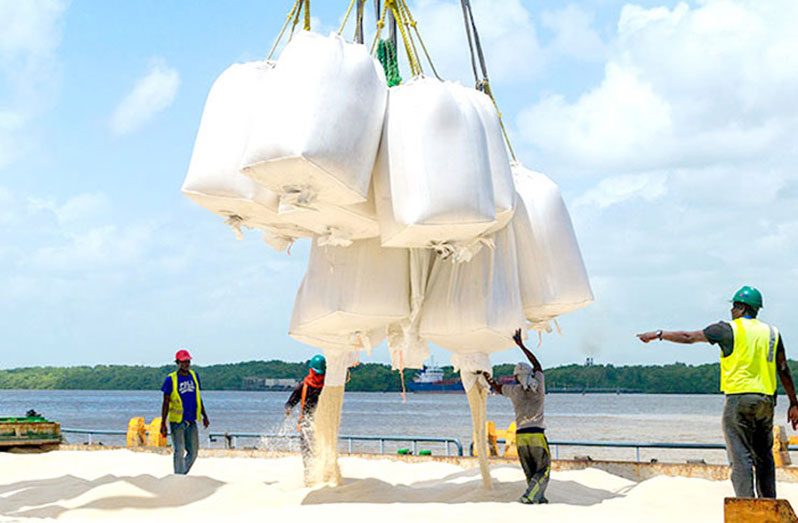EVEN with months of devastating floods which surpassed as much as 15 feet in some communities, Guyana’s agriculture sector has managed to perform satisfactorily and is still making strides, with the latest evidence of this being the receipt of US$189 million from the export of rice from January – December, 2021.
Returns from the export of this commodity reflect a slight decline due to the destructive effects of the May floods, especially the impact it had on key rice farming communities, especially in Regions Five (Mahaica-Berbice) and Six (East Berbice-Corentyne).

Figures provided by Agriculture Minister, Zulfikar Mustapha, show that for the year 2021, paddy production stood at 859,452 tonnes, with exports of paddy, rice and rice by-products weighing 412,810 tonnes.
Those export earnings were made possible due to the prompt flood response efforts initiated by the Ministry of Agriculture, which managed to salvage most of this year’s harvest, even as thousands of hectares of farmlands remained under water.
From the get-go, the Agriculture Ministry embarked on a series of massive drainage and irrigation works which led to floodwaters receding as fast as the rain would allow. But even then, rice earnings for this year were projected to fall, since many farmers could not have afforded to replant their crop due to heavy losses and damages which their fields sustained.
The dire outcome was prevented as the government spared no hesitation in rolling out a comprehensive flood-relief programme, which saw thousands of farmers in all sectors benefitting from cash grants totalling $7.8 billion.
Rice farmers, in particular, were given additional incentives including drainage and irrigation support as well as assistance with critical supplies including seed paddy and fertilisers, among other things.
This served as direct impetus for scores of farmers to return to their fields, resulting in the earnings recorded at the end of this year.
The support offered by the government is expected to have a direct impact on next year’s rice production numbers and its correlating figures of earnings, since the majority of rice farmers have already sown their first crop for 2022.
Although the expectations are high, the weather projections for this month have caused some worry; however, as a precautionary mechanism, President Dr. Irfaan Ali has activated a high-level flood response taskforce headed by Prime Minister, Brigadier (ret’d) Mark Phillips. This newspaper was informed that, so far, rice farmers have not been greatly affected by the ongoing rainy season.
Prior to the floods, amidst the COVID-19 pandemic, Guyana’s rice earnings stood at US$236.2 million (more than G$51 billion). This was earned from the exportation of 574,312 tonnes of paddy, rice and rice by-products during the past year. Prior to the pandemic, Guyana exported 481,2l2 tonnes, and earned US$201 million.
With rice production back on stream, Guyana has managed to secure a steadier market from its Caribbean sister-country, Barbados. And with rice prices on the rise, Barbados has reached out to its Caribbean Community (CARICOM) counterpart to organise a more stable agreement.
Minister Mustapha had related that Barbados’ request is for the supply of approximately 3,000 tonnes of rice at a slightly reduced cost, for the period November 2021 to December 2022.
Although Guyana has been exporting rice to Barbados since 1996, Minister Mustapha said that the two countries have been working tirelessly to strengthen bilateral relations, especially as it related to trade and investments.
The new arrangement, which could possibly be replicated across other sectors, forms part of President Ali’s efforts to increase trade within CARICOM, which will ultimately position Guyana to tap into, and perhaps even reduce the region’s hefty food importation bill. The government is already aiming to supply at least 25 per cent of the region’s imported products within the next four years.
As it is, the government is preparing to massively expand its rice production. In Region Three (Essequibo Islands-West Demerara) alone, plans are afoot to increase production by at least one million bags of paddy by 2025.
This scale up, Minister Mustapha previously said, is being accommodated by way of a number of investments which have already come on stream, and have begun to bear fruit.
Those include the reduction in ferry charges to transport paddy from the island of Wakenaam to Parika from $550 to $80 per bag; allowing for ferry charges to be paid on credit terms, while ensuring that farmers transporting paddy from Parika to Leguan island can return for free; increased seed paddy availability to farmers from 1,636 bags to 2,067 bags; the introduction of new paddy varieties, such as the GRBD 16, as well as the construction of more drying floors, among others.


.jpg)











